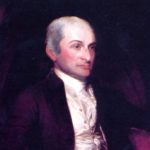A persistent constitutional myth has it that (1) Congress called the Constitutional Convention under the Articles of Confederation, (2) the convention drew its power from Congress, and (3) the convention exceeded its power when it recommended a new Constitution rather than merely propose amendments to the Articles.
As readers of this website know, however, the Constitutional Convention was not called by the Confederation Congress. It was called by Virginia and the commissioners (delegates) drew their authority from their respective state legislatures. All but two of those legislatures granted their commissioners full authority to recommend a new government.
This is further shown by a January 7, 1787 letter written by John Jay to George Washington. The letter also helps explain why the convention provided that the people, rather than the state legislatures, would ratify the Constitution.
The Jay Letter
In his letter, Jay first te lls Washington that he is glad Washington will participate in the convention. Jay specifically says the delegates’ authority “is to be derived from acts of the State Legislatures.” But he says he has some doubts: Only the people—not state legislatures—can change constitutions. However, Jay then acknowledges that the state commissioners can recommend change. What they can’t do is mandate change. Yet Jay fears that after the convention makes its recommendation, “party Heats” may ensue.
lls Washington that he is glad Washington will participate in the convention. Jay specifically says the delegates’ authority “is to be derived from acts of the State Legislatures.” But he says he has some doubts: Only the people—not state legislatures—can change constitutions. However, Jay then acknowledges that the state commissioners can recommend change. What they can’t do is mandate change. Yet Jay fears that after the convention makes its recommendation, “party Heats” may ensue.
Jay then suggests an alternative procedure: First, Congress should issue a statement that the Articles are inadequate, but without any particulars. Next, the state legislatures should authorize popular conventions to choose delegates to a general convention. The latter assembly would both write the changes and bind the people to them.
Thus, Jay understood that:
- the Constitutional Convention’s power came from the state legislatures, not from Congress;
- even without a popular mandate the Convention was free to propose; and
- popular consent was necessary to ratify a new constitution.
Of course, in predicting “party Heats” once the convention’s recommendations became public, Jay proved to be a prophet.
The Constitutional Convention Chooses a Different Procedure
Jay was not a commissioner to the Constitutional Convention. That body, with congressional approval, agreed that the people’s consent was necessary for the new Constitution. But the Constitutional Convention opted for a different procedure: Instead of popular conventions electing a general convention that would bind everyone to change, the general convention would propose change and the popular gatherings would ratify or reject.
